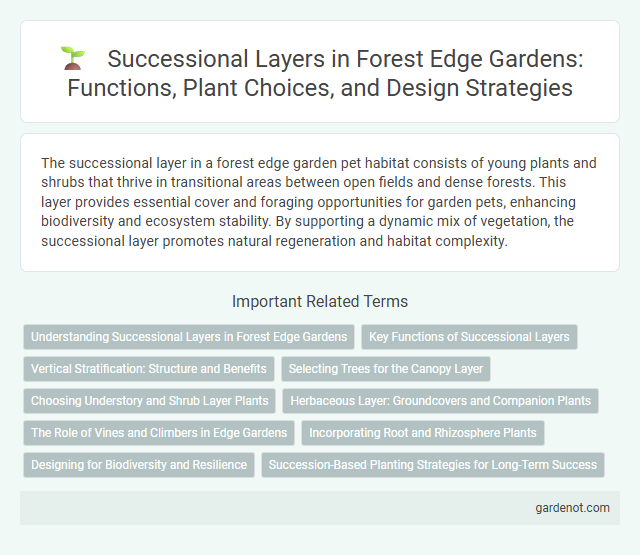The successional layer in a forest edge garden pet habitat consists of young plants and shrubs that thrive in transitional areas between open fields and dense forests. This layer provides essential cover and foraging opportunities for garden pets, enhancing biodiversity and ecosystem stability. By supporting a dynamic mix of vegetation, the successional layer promotes natural regeneration and habitat complexity.
Understanding Successional Layers in Forest Edge Gardens
Successional layers in forest edge gardens represent distinct plant communities at various growth stages that contribute to biodiversity and habitat complexity. Early successional layers often feature fast-growing herbaceous plants and shrubs, while mid to late successional layers include young trees and mature canopy species adapting to changing light and soil conditions. Understanding these layers helps optimize plant selection and garden design to enhance ecological stability and support wildlife.
Key Functions of Successional Layers
Successional layers in a forest edge garden play a crucial role in enhancing biodiversity by creating varied habitats for wildlife and promoting soil stability through root diversity. These layers facilitate nutrient cycling and organic matter accumulation, supporting plant growth and ecosystem resilience. By providing vertical structure, they also optimize light capture and microclimate regulation, essential for sustaining both early and late successional species.
Vertical Stratification: Structure and Benefits
The successional layer in a forest edge garden exhibits distinct vertical stratification, enhancing biodiversity by providing multiple habitat niches from ground cover to emergent canopy. Vertical layering optimizes sunlight interception, nutrient cycling, and microclimate regulation, promoting plant growth and resilience. This structural complexity supports diverse wildlife, including pollinators and predators, contributing to ecosystem stability and productivity.
Selecting Trees for the Canopy Layer
Selecting trees for the canopy layer in a forest edge garden involves choosing species that promote biodiversity and ecological balance. Opt for native hardwoods such as oak (Quercus spp.), hickory (Carya spp.), and tulip poplar (Liriodendron tulipifera) to provide habitat and food sources for wildlife. These canopy trees support successional layers by creating shade that encourages understory growth, fostering a dynamic and resilient forest edge ecosystem.
Choosing Understory and Shrub Layer Plants
Selecting understory and shrub layer plants for a forest edge garden requires emphasizing species adapted to partial shade and variable moisture conditions. Ideal choices include native shrubs like spicebush (Lindera benzoin) and deciduous ferns that support local wildlife and promote biodiversity. Incorporating diverse successional layers enhances soil health and creates habitat complexity crucial for ecosystem stability.
Herbaceous Layer: Groundcovers and Companion Plants
The herbaceous layer in a forest edge garden primarily consists of groundcovers and companion plants that stabilize soil and enhance biodiversity by providing habitat and food for pollinators. Species like wild ginger, violet, and creeping thyme thrive in shaded or partially shaded areas, reducing weed growth and moisture loss through their dense foliage. Companion plants such as goldenrod and black-eyed Susan support native pollinator populations and improve overall ecosystem health within the successional vegetation layers.
The Role of Vines and Climbers in Edge Gardens
Vines and climbers play a crucial role in the successional layers of forest edge gardens by creating vertical diversity and enhancing habitat complexity. These plants support biodiversity by providing food and shelter for pollinators, birds, and small mammals while stabilizing soil with their extensive root systems. Their growth patterns facilitate natural succession processes, enabling the gradual transition from herbaceous layers to woody vegetation.
Incorporating Root and Rhizosphere Plants
In forest edge gardens, incorporating root and rhizosphere plants enhances soil health and nutrient cycling by fostering symbiotic microbial communities. These plants improve soil structure, increase organic matter content, and support deeper nutrient uptake, promoting resilient successional layers. Effective selection of species such as nitrogen-fixing legumes and mycorrhizal-associated perennials optimizes ecosystem functions at the forest edge interface.
Designing for Biodiversity and Resilience
Successional layers in a forest edge garden enhance biodiversity by creating a variety of microhabitats that support diverse plant and animal species. Designing with multiple strata, including herbaceous ground covers, shrubs, and canopy trees, fosters ecological resilience against pests and environmental stressors. Integrating native species within these layers promotes nutrient cycling, habitat connectivity, and long-term ecosystem stability.
Succession-Based Planting Strategies for Long-Term Success
Succession-based planting strategies in forest edge gardens involve carefully selecting plant species that naturally follow one another to create a stable, multi-layered ecosystem. Early successional plants such as grasses and herbaceous species establish quickly, improving soil conditions and providing shade for later successional shrubs and trees. This approach enhances biodiversity, supports wildlife habitats, and ensures long-term garden resilience by mimicking natural forest succession processes.
Successional layer Infographic

 gardenot.com
gardenot.com